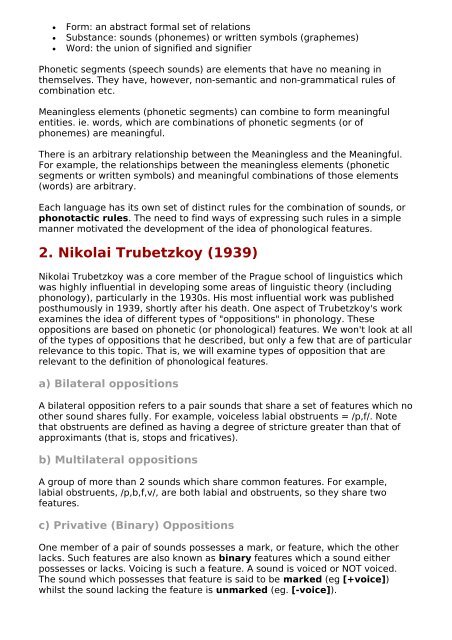Distinctive Features - Speech Resource Pages - Macquarie University
Distinctive Features - Speech Resource Pages - Macquarie University
Distinctive Features - Speech Resource Pages - Macquarie University
Create successful ePaper yourself
Turn your PDF publications into a flip-book with our unique Google optimized e-Paper software.
• Form: an abstract formal set of relations<br />
• Substance: sounds (phonemes) or written symbols (graphemes)<br />
• Word: the union of signified and signifier<br />
Phonetic segments (speech sounds) are elements that have no meaning in<br />
themselves. They have, however, non-semantic and non-grammatical rules of<br />
combination etc.<br />
Meaningless elements (phonetic segments) can combine to form meaningful<br />
entities. ie. words, which are combinations of phonetic segments (or of<br />
phonemes) are meaningful.<br />
There is an arbitrary relationship between the Meaningless and the Meaningful.<br />
For example, the relationships between the meaningless elements (phonetic<br />
segments or written symbols) and meaningful combinations of those elements<br />
(words) are arbitrary.<br />
Each language has its own set of distinct rules for the combination of sounds, or<br />
phonotactic rules. The need to find ways of expressing such rules in a simple<br />
manner motivated the development of the idea of phonological features.<br />
2. Nikolai Trubetzkoy (1939)<br />
Nikolai Trubetzkoy was a core member of the Prague school of linguistics which<br />
was highly influential in developing some areas of linguistic theory (including<br />
phonology), particularly in the 1930s. His most influential work was published<br />
posthumously in 1939, shortly after his death. One aspect of Trubetzkoy's work<br />
examines the idea of different types of "oppositions" in phonology. These<br />
oppositions are based on phonetic (or phonological) features. We won't look at all<br />
of the types of oppositions that he described, but only a few that are of particular<br />
relevance to this topic. That is, we will examine types of opposition that are<br />
relevant to the definition of phonological features.<br />
a) Bilateral oppositions<br />
A bilateral opposition refers to a pair sounds that share a set of features which no<br />
other sound shares fully. For example, voiceless labial obstruents = /p,f/. Note<br />
that obstruents are defined as having a degree of stricture greater than that of<br />
approximants (that is, stops and fricatives).<br />
b) Multilateral oppositions<br />
A group of more than 2 sounds which share common features. For example,<br />
labial obstruents, /p,b,f,v/, are both labial and obstruents, so they share two<br />
features.<br />
c) Privative (Binary) Oppositions<br />
One member of a pair of sounds possesses a mark, or feature, which the other<br />
lacks. Such features are also known as binary features which a sound either<br />
possesses or lacks. Voicing is such a feature. A sound is voiced or NOT voiced.<br />
The sound which possesses that feature is said to be marked (eg [+voice])<br />
whilst the sound lacking the feature is unmarked (eg. [-voice]).
















